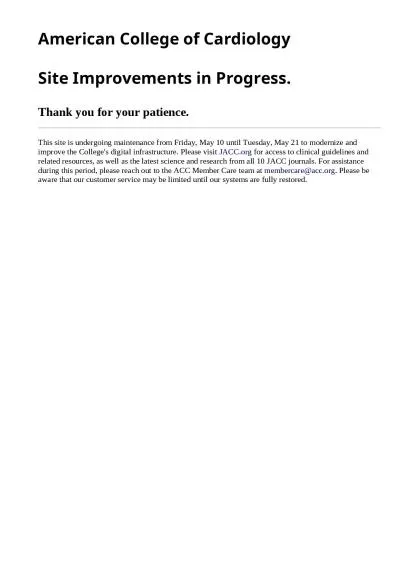

TREDHF Brian P Halliday MBChB PhD On behalf of Sanjay K Prasad PI John GF Cleland coPI Rebecca Wassall Amrit Lota Zohya Khalique John Gregson Dudley J Pennell Stuart D Rosen Martin R Cowie and the TREDHF investigators ID: 913537
Download Presentation The PPT/PDF document "Withdrawal of pharmacological therapy fo..." is the property of its rightful owner. Permission is granted to download and print the materials on this web site for personal, non-commercial use only, and to display it on your personal computer provided you do not modify the materials and that you retain all copyright notices contained in the materials. By downloading content from our website, you accept the terms of this agreement.
Slide1
Withdrawal of pharmacological therapy for heart failure in recovered dilated cardiomyopathy – a randomised trial TRED-HF
Brian P Halliday MBChB PhDOn behalf of Sanjay K Prasad (PI), John GF Cleland (co-PI), Rebecca Wassall, Amrit Lota, Zohya Khalique, John Gregson, Dudley J Pennell, Stuart D Rosen, Martin R Cowie and the TRED-HF investigators
11th November 2018
Slide2TRED-HF
Open-label, pilot randomised trialExamine safety and feasibility of phased therapy withdrawalRecruitment from network of hospitals; enrolment in single centre
Prior diagnosis of DCMDilated and LVEF<40% at diagnosisSubsequent recoveryLVEF>50% Normal LVEDVi NT-pro-BNP <250ng/LNYHA 1 }CMRArrhythmia requiring beta-blockerUncontrolled hypertensionValvular disease (moderate or greater)eGFR<30mls/minPregnancy
AnginaAge <16 years
Slide3Screening visit
Clinical assessment, symptom questionnaires, NT-pro-BNP, CMR, CPET
Randomisation 1 to 1Continued therapyClinic visit at 8 weeksClinical assessment and NT-pro-BNPReduce/stop loop diuretics
Reduce/stop MRAs
Reduce/stop beta-blockers
Reduce/stop ACE inhibitors or ARB
Clinic review every 4 weeks
Clinical assessment and NT-pro-BNP
Interim telephone review
16 week follow-up visit
Clinical assessment, NT-pro-BNP, CMR
6 month follow-up visit
Clinical assessment, symptom questionnaires, NT-pro-BNP, CMR, CPET
Therapy withdrawal using the same protocol
Randomised
phase
Single arm cross-over phase
Mimic what happens in clinical practice
Slide4Primary end-pointRelapse of DCM defined by any 1 of:
Safety end-point (CV mortality, MACE, unplanned CV hospitalisation)Arrhythmia end-point (sustained)Changes in secondary clinical variables
Reduction in LVEF by >10% and to below 50%Increase in LVEDV by >10% and to above normal rangeTwo-fold rise in NT-pro-BNP and to >400ng/LClinical evidence of heart failurePre-specified end-pointsImmediate re-introduction of therapy
Slide5Baseline
Therapy Withdrawal (n=25)Control (n=26)Demographics Median Age (IQR), yrs
54 (46,64)
56 (45,64)
Men, n (%)
16 (64)
18 (69)
Previous cardiovascular history
Time since initial DCM diagnosis, months
63 (36,112)
41 (20, 91)
LVEF at initial diagnosis, %
28 (20,33)
25 (19,33)
Absolute improvement in LVEF, %
29 (23,36)
30 (25,38)
Time since LVEF>50%, months
28 (8,45)
20 (6,44)
Previous heart failure admission, n (%)
18 (72)
14 (54)
Previous moderate alcohol excess, n (%)
8 (32)
9 (35)
Previous atrial fibrillation, n (%)
8 (32)
4 (15)
Aetiology
Idiopathic, n (%)
20 (80)
15 (58)
Familial, n (%)
3 (12)
4 (15)
Environmental insult, n (%)
2 (8)
7 (27)
TTNtv
, n (%)
7 (28)
4 (15)
Medications at enrolment
ACE inhibitor /ARB, n (%)
25 (100)
26 (100)
Beta-blocker, n (%)21 (84)24 (92)Mineralocorticoid receptor antagonist, n (%)12 (48)12 (46)Loop diuretic, n (%)3 (12)3 (12)Clinical characteristics at enrolment Heart rate, beats per minute62 (58,74)70 (60,75)Systolic blood pressure, mmHg123 (117,133)127 (117,134)Diastolic blood pressure, mmHg72 (68,80)76 (70,80)Left bundle branch block, n (%)3 (12)4 (15)QRS duration, ms98 (85,108)94 (88,111)NT-pro-BNP, ng/l72 (44,147)75 (37,133)CMR variables at enrolmentLVEDVi, ml/m286 (66, 91)80 (70,91)LVEF, %62 (55, 66)60 (55,61)
Median age: 55 years (IQR 45 to 64)34 (67%) menAt first diagnosis Median LVEF: 25% (IQR 20 to 33)Median time from diagnosis: 4.9 yrs (IQR: 2.1 to 8.3)At enrolmentAll in sinus rhythmMedian LVEF: 60% (IQR 55 to 64)Median NT-pro-BNP: 72ng/L (IQR 39 to 135)All patients on ACEi/ARB45 (88%) on beta-blocker24 (47%) on MRA6 (12%) on loop diuretic1 pt had CRT-D and 1 pt an ICD in situ
Slide6Results
Randomised phase
ArmPtsRelapse n (%)Therapy withdrawal
25
11 (44)
Control
26
0 (0)
Single-arm cross-over phase
Of 50 pts who began therapy withdrawal, 20 (40%) met primary end-point
25 of 50 (50%) patients completed follow-up without re-initiation of treatment
Arm
Pts
Relapse
n (%)
Therapy withdrawal
25
9 (36)
Further 3 restarted therapy
2 for hypertension, 1 for AF
16 of 50 (32%) completed withdrawal without deterioration in LVEF (>3%)
Slide7Safety end-points
No deaths, unplanned heart failure hospitalisations or MACE3 serious adverse events in withdrawal armHospitalisations: urinary sepsis, non-cardiac chest pain and an elective procedureNo sustained ventricular arrhythmia or device therapiesThree pts developed AF in withdrawal armAll pts who met primary end-point were asymptomatic at follow-up17 of 20 pts had LVEF>50%2 had LVEF 45-50% and 1 had LVEF 43%
Slide8Conclusion
Withdrawal of pharmacological heart failure therapy from patients deemed to have recovered DCM resulted in relapse in ~40% of casesLikely to be greater in medium- and long-termWithdrawal of therapy should not usually be attempted, untilPredictors of relapse are definedBetter understanding of importance of specific therapiesMonitoring in placeImprovement in function represents remission rather than permanent recovery for many patients
Slide9Acknowledgements
Sanjay K Prasad (PI)
John GF Cleland (co-PI)
Martin R Cowie
Stuart D RosenDudley J PennellStuart A CookA John Baksi
Rebecca Wassall
Amrit S Lota
Zohya Khalique
John Gregson
Simon Newsome
James S Ware
Tsveta Rahneva
Robert Jackson
Rick Wage
Gillian Smith
Lucia Venneri
Upasana Tayal
William Midwinter
Nicola Whiffin
Dominique Auger
Ronak Rajani
Jason Dungu
Antonis Pantazis
TRED-HF Investigators
Patients